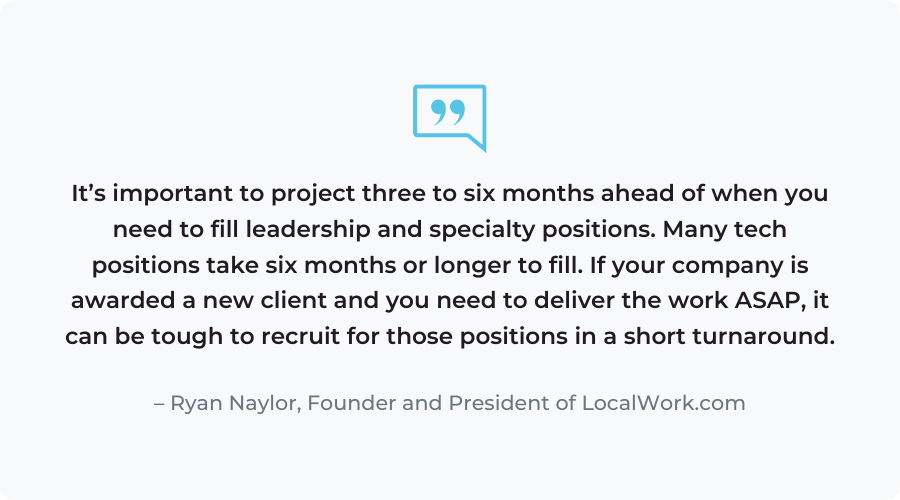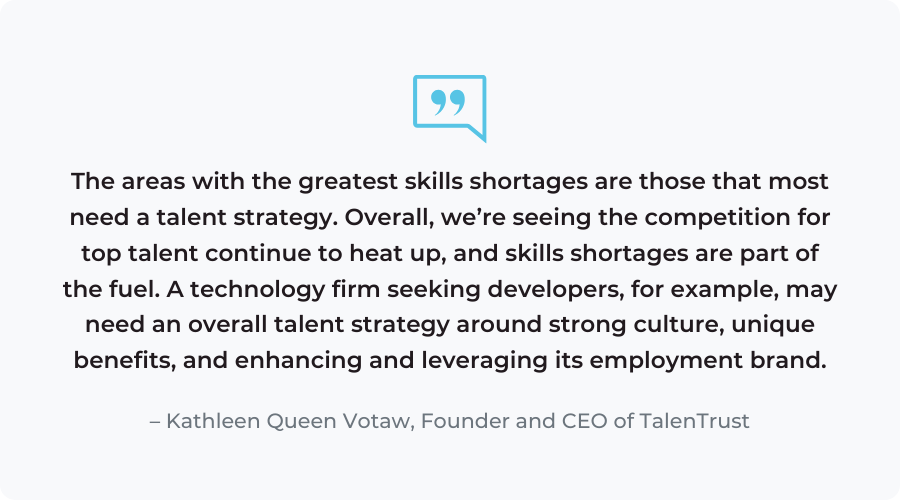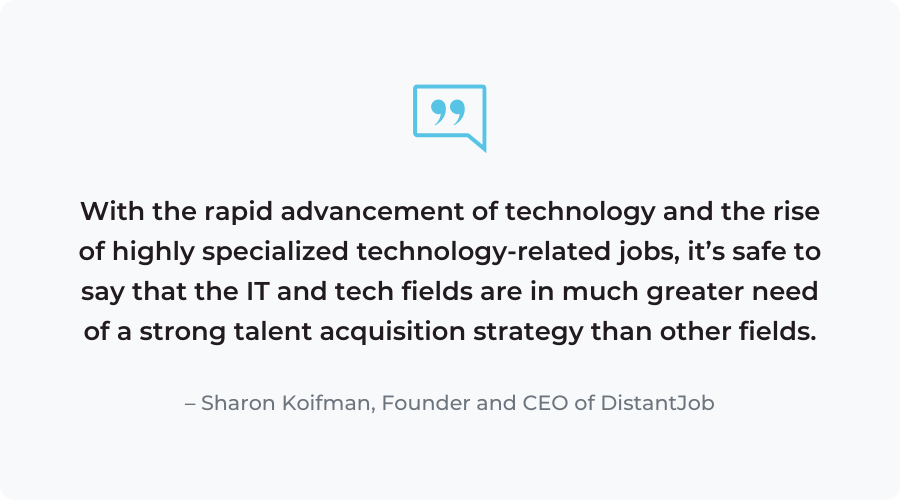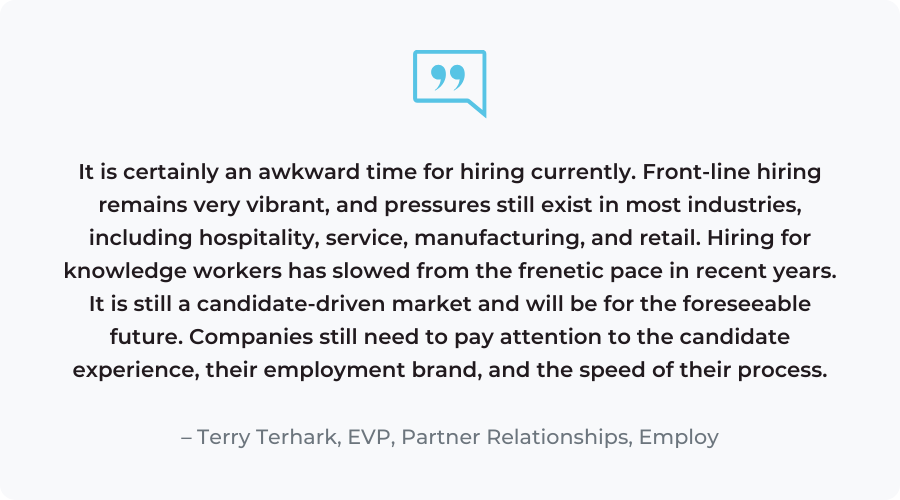
This article on recruitment versus talent acquisition first appeared in May 2021 and has been updated most recently in January 2024 with new information and insights.
Many people think that the terms recruitment and talent acquisition are synonymous, but companies that keep an eye on the big picture know there’s a crucial difference between the two.
Recruitment and talent acquisition are comparable to short-term and long-term — quick fixes versus a longer-term approach. Both approaches may be used depending on the circumstances, but one is more tactical in nature and the other is more strategic.
Internal hiring managers can improve overall recruitment planning with a basic understanding of the strategic nature of talent acquisition. And recruiters can enhance employer relationships by better understanding talent acquisition’s unique role in helping a company achieve its strategic vision.
Recruitment Versus Talent Acquisition
Recruitment is about filling vacancies. Talent acquisition is an ongoing strategy to find your company’s top specialists, individual contributors, leaders, or future executives.
Recruitment refers to the process of identifying, attracting, and hiring individuals for an open position within a short period. The primary focus is to fill vacancies as efficiently as possible by selecting the best-fit candidate based on job requirements and the applicant’s skill set. Recruitment usually involves screening resumes, conducting interviews, and making a job offer.
Talent acquisition, on the other hand, is a comprehensive and proactive strategy to identify, attract, and nurture potential hires for future positions often before these positions become available.
Talent acquisition focuses on long-term human resources planning by investing time and resources in building relationships with potential candidates, promoting employer branding, and developing a talent pipeline for future organizational needs. This approach considers not only applicant skills and competencies, but also potential fit within the company’s culture and long-term growth goals.
Ryan Naylor, founder and President of LocalWork.com, a company connecting local jobs with local job seekers, said talent acquisition “is more focused on the strategic side of tougher positions to fill.”

Companies must ask themselves which positions will be difficult to fill when a vacancy or need arises. Niche markets, technology skills, highly specific experience, and leadership roles call for a thoughtful, long-term approach to talent acquisition.
More than half of talent professionals (57%) believe within the next 12 months, hiring new employees will be challenging because there are:
• Not enough quality candidates (58%)
• Competition from other employers (46%)
• Fewer recruiters or recruiting resources (43%)
• More employees leaving the organization (41%)
Should Your Company Recruit or Acquire Talent?
Many markets are changing, and new skills are needed. In manufacturing, a push towards green technology leads to a greater need for reskilling and hiring non-traditional backgrounds, such as environmental science or cybersecurity.
The competition for this talent is fierce. Your company should have a talent acquisition strategy in place to anticipate these needs. Having a passive talent pool ready will save you time and give you a leg up on your competition.
Kathleen Quinn Votaw, Founder and CEO of TalenTrust, a human resource consulting firm, and author of Solve the People Puzzle: How High-Growth Companies Attract and Retain Top Talent, has seen the competition for the best talent escalate.

Sharon Koifman, Founder and CEO of DistantJob, a recruiting firm specializing in placing virtual employees, and an expert in global recruitment, agrees.

Some professionals may believe that every company in all industries should focus on talent acquisition rather than recruitment because acquiring talent typically builds a stronger company, fosters teamwork, and boosts productivity. But remember, having a robust talent acquisition strategy benefits your organization based on the degree you hire and the complexity of your hiring function.
If high turnover rates characterize your industry, you can transform hiring by building a more robust talent pool through strategic talent acquisition. But if you only hire a few people each year and have low turnover, your focus is likely more on recruitment.
Terry Terhark, EVP, Partner Relationships for Employ, also weighs in on what hiring looks like for specific industries:

How to Move Beyond Recruitment to Acquire Top Talent
Attracting the best and brightest employees to your company isn’t a one-time-only event. It is a continuous process of networking and building relationships with top talent.
While recruitment remains an important activity to fill immediate vacancies, talent acquisition is a long-term strategy to make your hiring more efficient and more productive.
New talent will be attracted to your company as a great workplace, and the company will thrive. Your talent acquisition function can be one of the drivers of corporate success and an integral part of the team propelling your company to grow.
Jumpstart Your Talent Acquisition Efforts
We’re here to help. Jobvite’s EVOLVE TA Framework assesses your organization’s maturity in 17 process areas across the three pillars of TA: recruitment marketing, applicant management, and TA operations.
Learn how to optimize not just the process areas, but also the connection points between process areas to see real business results. Based on your current maturity level in the identified process areas, we’ll provide tailored action plans to evolve your processes, people, and technologies and track your progress.
Looking to learn more about what Jobvite’s Evolve Talent Acquisition Suite can do for your team? To see Jobvite in action, watch the on-demand Jobvite Product Tour or request a live demo.
